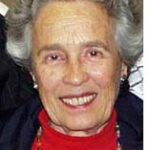By Eileen Wingard

SAN DIEGO — Was it the Charger game or the community-wide Challah Bake that limited the attendance at the Daniel Pearl Memorial Program at Smith Recital Hall on the SDSU Campus? Whatever the reason, those absent, as evident from a sprinkling of empty seats, missed a remarkable evening, merging music, dance and poetry of many faiths in two and a half hours of inspirational programming.
It was a fitting memorial to commemorate the life of a young, talented journalist who loved humanity and enjoyed playing music.
The program opened with a heart-warming rendition of In Memorium for cello and strings by Gerard Schwarz, performed by Marcia Bookstein, cellist, and a string ensemble from the Tifereth Israel Community Orchestra, conducted by David Amos. Bookstein’s passionate playing opened with a solo introduction begun in the lowest reaches of the cello. The strings joined several bars later to accompany her. Although this work shows strong influence of Ernest Bloch’s music, it has its own dissonant, modern twist.
The TICO group then played Julius Chajes Israeli Dances. The finale, “Song of Galilee,” was filled with interesting counterpoint. It was carefully propelled forward to a lilting climax by Conductor David Amos.
Next, three dancers performed to a score composed by Yale Strom and titled, Nineveh By Way of Haifa. The choreography was by the innovative John Malashock. In a stunning entrance, supple-bodied Stephanie Harvey, with undulating arms and posed in a split, was borne on the shoulders of Nicholas Strasburg and Justin Viernes.
The dancers reflected emotions of love and hate. The two men sparred, after tossing Harvey to the ground with abusive fervor. She rolled over several times, looking devastated. Upright, she renewed contact, first with one, then the other, and finally, the men elevated her once again as they exited. The movements of these remarkable members of the Malashock Dance Company were mesmerizing.
Common Chords filled the rest of the program, combining Yale Strom’s Hot P’Stromi musicians, Elizabeth Schwartz, vocals, Yale Strom, violin, Tripp Sprague, tenor sax/flute, Meir Shitrit, guitar/bouzouki, Mark Dresser, bass, Sunny Jain, percussion, with the famous Persian singer, Hamed Nikpay, vocals/ oud, and the Indian tabla virtuoso, Samir Chatterjee.
Nikpay sang several solos with lyrics by the Persian Poet, Rumi. The Persian vocalist’s voice was warm and full. In one selection, he began a song and Elizabeth harmonized, then it morphed into the Hebrew, V’taher Libenu (Purify our Hearts). Another memorable song was Strom’s original “What Time Will It Be?” which includes Herzl’s famous words, “Im Tirzu Ein Zo Agada,” (If you will it, it is not a dream.) During the seven selections, there were memorable solo riffs by each musician. Mark Dresser played his bass as if it were a cello, so melodious and beautiful did it sound, Tripp Sprague drew some unusual colors from his flute, Meir Shitrit, a new face in the group, played the bouzouki with impressive virtuosity and Samir Chatterjee was deft with his rhythmic magic on the tablas.
Jewish, Christian, Muslim and Hindu words were read, reflecting the pursuit of peace in all these faiths.
If only these peace-loving musicians could influence the politicians determining the fate of the world.
Sara-Appel-Lennon, committee chair, and her co-chair, CK Lennon, are to be congratulated for putting together such an impressive program with so many diverse elements.
San Diego State University’s Judaic Studies Department, under the directorship of Dr. Risa Levitt-Kohn with Scholar-in-Resident Yale Strom, deserve thanks for all they did to make this program possible. Other sponsors were Temple Emanu-El, Tifereth Israel Synagogue, and the Jewish Federation of San Diego County.
*
Wingard, a retired violinist with the San Diego Symphony, is a freelance writer specializing in coverage of the arts. She may be contacted via eileen.wingard@sdjewishworld.com